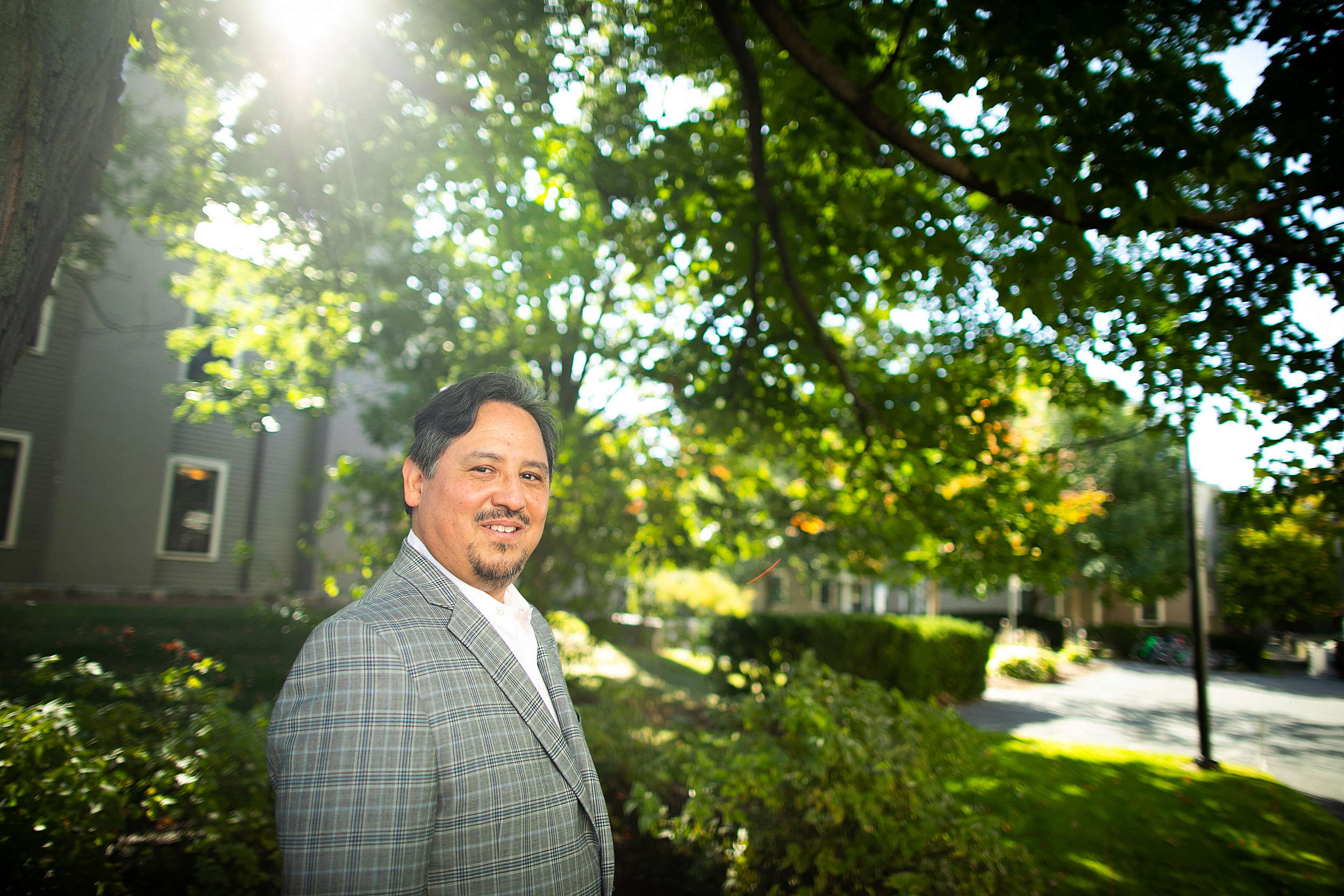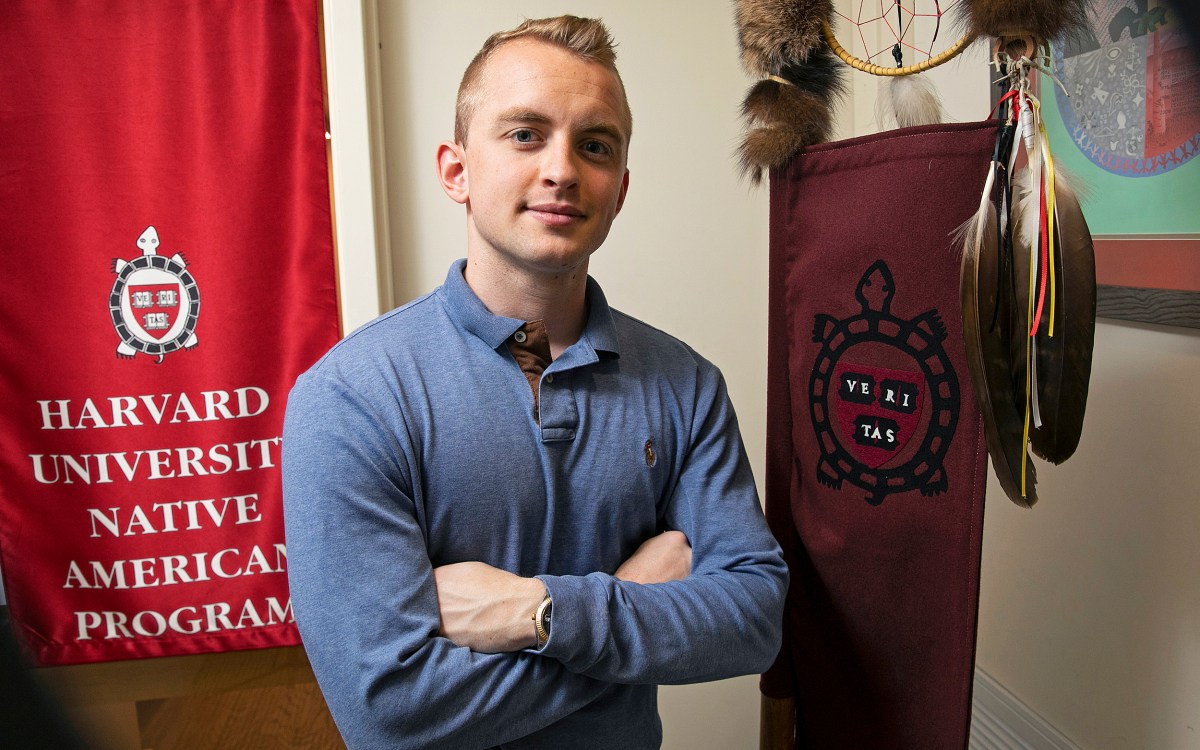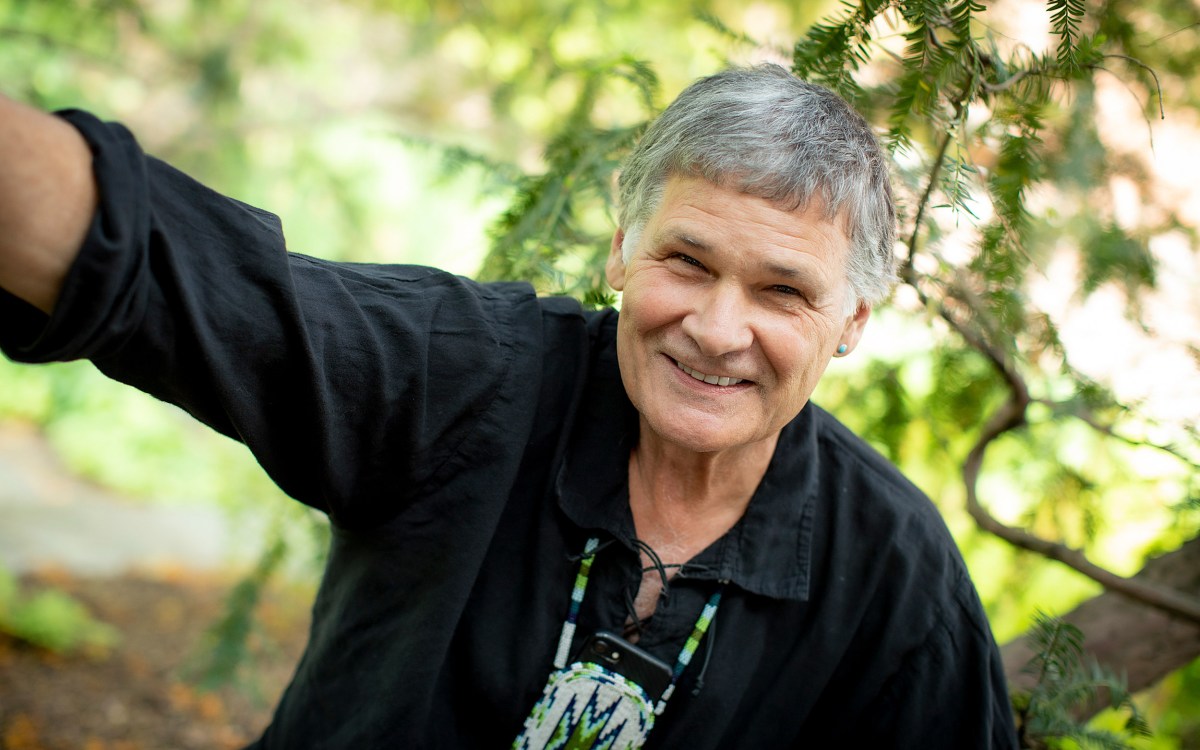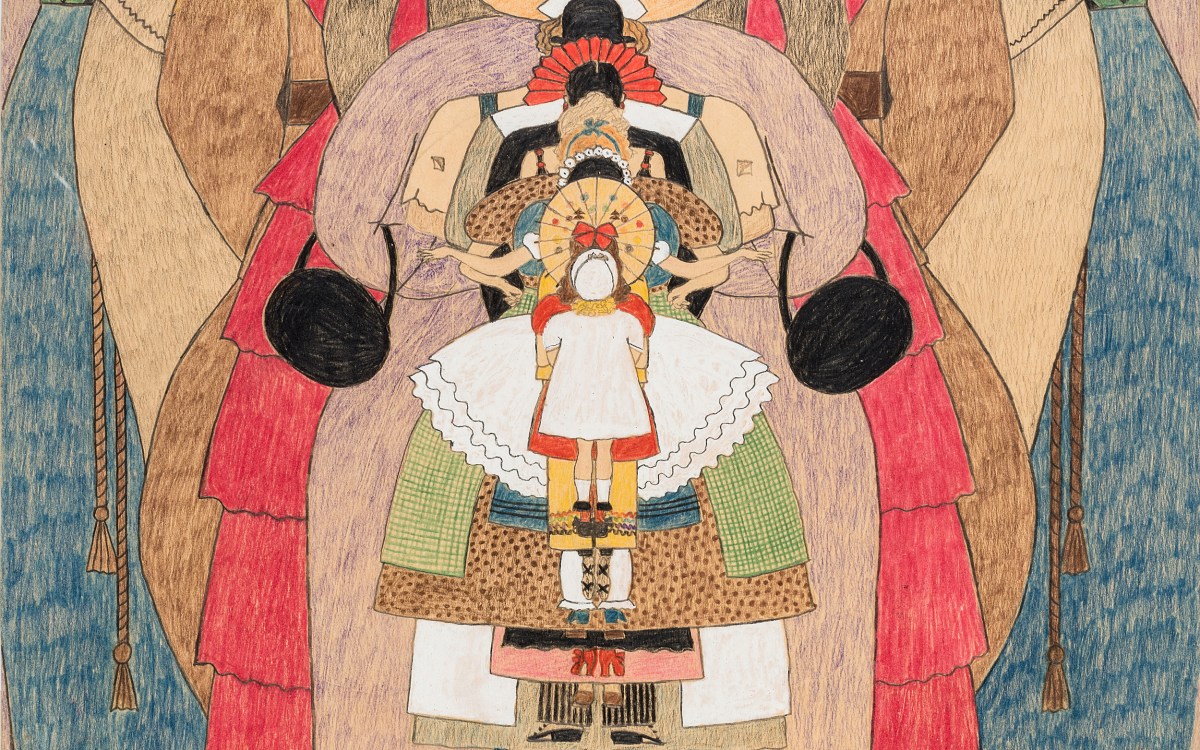
Joseph P. Gone explains how his past education and experiences will help guide HUNAP’s development.
Stephanie Mitchell/Harvard Staff Photographer
Looking ahead, informed by where he’s been
Joseph Gone discusses what he hopes to achieve as new faculty director of Native American Program
Joseph P. Gone, the new faculty director of the Harvard University Native American Program (HUNAP), is a 1992 graduate of Harvard College who returned to the University last year as professor of anthropology in the Faculty of Arts and Sciences and professor of global health and social medicine in the Faculty of Medicine. He assumed this new post in July.
Hailing from Montana, Gone is an interdisciplinary social scientist with both theoretical and applied interests who has spent the last 25 years working with indigenous communities to rethink community-based mental health services, and to harness traditional culture and spirituality for advancing indigenous well-being. Most recently, Gone, who is a member of the Aaniiih-Gros Ventre tribe, directed the Native American Studies Program at the University of Michigan. In 2014, he was awarded a Guggenheim Fellowship, and he is currently a fellow in the Interdisciplinary Research Leaders Program of the Robert Wood Johnson Foundation. The Gazette recently sat down with Gone to discuss the challenges and goals of his new role.
Q&A
Joseph Gone
GAZETTE: You were a student here in the 1990s so I’m wondering whether you think that experience will influence your work as the new HUNAP director.
GONE: Yes, absolutely. When I was here as an undergraduate [Gone later did predoctoral training through Harvard Medical School at McLean Hospital], I was interested in connecting to other native students, yet there was a very small undergraduate native student body at the time, much smaller than it is now. I was an older College student, too, as I had served in the U.S. Army, so I connected to some of the native graduate students on campus. At that time, they congregated at Read House, which encompassed the Native American Program through the Graduate School of Education. I found a wonderful group of folks there. I learned a lot from them, and I got involved in the things for which they were advocating. Primary among those issues was getting the Native American Program out from underneath the education umbrella and into a broader Harvard-wide status that was more inclusive of all of our interests. We held a pipe ceremony at the time to inaugurate our efforts to try and get this done, and we started meeting with President [Neil] Rudenstine, and we made our case. Not long after I graduated, what would become HUNAP was inaugurated as a University-wide program under the auspices of the Provost’s Office, a development that has been very important to the program’s longevity and growth.
GAZETTE: You were hired as professor of anthropology in the Faculty of Arts and Sciences and professor of global health and social medicine in the Faculty of Medicine in 2018, and then, Dennis Norman stepped down as director of HUNAP. Did you have a sense that the HUNAP director role might be a next step for you?
GONE: When I was recruited to be a faculty member here last year, it certainly hadn’t occurred to me. I was new here, and I was trying to get my research program established and learn my new departments. I’m a psychologist, but I’m now based in a department of anthropology and social medicine — all of this is new for me. So when I was notified to come meet the provost, and he proposed this to me I thought, “Wow, is now the right time for me to do this? Can I get my sea legs first?” But it’s all worked out, and I’m really excited to get the chance to facilitate the setting of a vision for what HUNAP can become over these next years.
GAZETTE: You’ve just begun your work at HUNAP, but what are some of your initial goals for the program?
GONE: There’s a real wealth of opportunity here. Initially, I’m hopeful that we can facilitate a process among the four native studies faculty who arrived last year, and some who have already been here teaching, to collectively figure out what HUNAP should look like. I’m hard at work to come up to speed with all that HUNAP is doing, and to figure out how to build on its successes and navigate its challenges. We have three fantastic staff members who have been here for years, which is going to help us a lot through this process.
GAZETTE: Do you have any specific program ideas you’re considering?
GONE: One thing we can do more of, I think, is to sponsor and support academic-scholarly research. We have to figure out exactly what that looks like. Certainly, that includes not just some of our own programming which is driven by the faculty members who already engage in native and indigenous studies, but also trying to elicit, seed, and invest in other faculty projects around the University — in native health in the teaching hospitals, for example. How do we coordinate and consolidate and build on efforts from folks in Harvard’s Schools and units who have already been doing a lot, with sometimes a little, and who have been making strong commitments to advancing knowledge about indigenous peoples and improving Indian lives?
GAZETTE: Tell us more about the four new faculty members on campus you expect to have a role in shaping HUNAP’s future.
GONE: There were four faculty in 2018, including myself, who arrived to Harvard with Native American and indigenous studies interests. Phil Deloria, in the Department of History, is an eminent senior scholar in Native American studies, and in the year since I’ve been back at Harvard he’s been visible all over campus. Phil is a fantastically capable and accomplished ambassador for Native American studies on campus and of course around the world. My partner Tiya Miles. Phil recruited and hired both of us at Michigan, years and years ago, in 2002, where we together built a Native American studies program. Tiya’s work is at the intersection of black and native lives historically with an emphasis on slavery, pre-Civil War. Shawon Kinew, in the Department of History of Art and Architecture, is teaching a class this year in the Peabody Museum, which centers around some historical portraits of native people there. And we join some wonderful people who are already on the faculty — Matt Liebmann and Dan Carpenter, just to name two.
GAZETTE: You didn’t mention your own research interest, which is particularly fascinating in how it exists at the intersection of culture, coloniality, and well-being in indigenous communities. Tell us more about your work.
GONE: Psychology is a very big discipline; it ranges from brain science to philosophical questions of what it means to be human. There’s a lot of room to move, and this was important to me early on in my career because I both wanted to be relevant to improving people’s lives, but also, I like ideas, and I wanted to be able to grapple with ideas seriously and substantively. I received my doctorate in clinical-community psychology, which is this interesting hybrid of two subfields in the discipline, clinical being concerned with the assessment and treatment of mental health problems, and community psychology being a renegade breakaway effort and critique of clinical psychology, which alleged that the medical model, in broad terms, was too limiting on what psychologists had to contribute to the betterment of society.
“Native students at Harvard, and broadly in higher education, need to be armed with the mindset that they made the cut, that Harvard can be their place too, and then, like all students, they have to find a way to make it their own.”
Community psychology suggests that empowering clients and changing settings so that people can thrive can be more important than tinkering with their psychodynamics; that trying to develop resources to cultivate citizen engagement can be more effective than merely medicalizing and treating individuals. This perspective is particularly helpful in Indian country because Indian peoples are colonized, formerly colonized, or post-colonial peoples. We have a long history of subjugation, dispossession, and impoverishment that puts us at risk for certain kinds of mental health conditions; the ones that are really rampant are of course addiction, the aftermath of violence, PTSD, trauma, and suicide. These are classified in psychiatry’s handbook in different ways, but in Indian country they’re probably best understood as post-colonial conditions. So the question becomes: How can we be helpful to Indian people grappling with these concerns without reproducing the kinds of colonial relations that gave rise to them to begin with? How do we take culture into account, and think outside of current paradigms to at least begin to question what are the assumptions and presumptions of the mental health profession?
GAZETTE: Can you unpack that a little for us?
GONE: Let’s take a basic example when it comes to psychotherapy — the presumed relevance of talk as a therapeutic activity. Therapeutic talk is of course self-reflective; it requires a willingness to explore one’s interiority, and to communicate what one finds through language and related forms of self-expression. I would suggest to you that most of the world’s population is not particularly psychologically minded in that way. Obviously, psychological-mindedness has arrived with modernity and it has diffused widely, globally, and has circulated in many ways, and maybe soon most of the world will be psychologically-minded. But I’m not sure it is yet, and we can’t assume that Indian people are that way. And if we don’t assume that, then we need to understand that there’s some large swath of the Native American population who are, in a sense, being socialized into psychological-mindedness through therapy.
GAZETTE: In what other ways does culture play a role?
GONE: What I call in my work the “postcolonial predicament” for Indian mental health services is the simple fact that on the one hand we suffer from “mental health” conditions at alarming rates, but on the other hand, available services are not necessarily commensurate with who we are and where we’re at relative to therapeutic benefit. Figuring out what to do about that has been the focus of my research for 25 years. I try to tinker and refine psychotherapy to work with native community members, or even re-envision what therapeutic activity looks like altogether, starting with incorporating native traditions, indigenous therapeutic traditions, healing of various kinds, and figuring out how to make these traditions a relevant part of service delivery rather than, we might say, taking an established form of psychotherapy and “dressing” it in beads and feathers and hoping Native Americans buy into it. What’s at stake here is about who we are as beings; it’s about what it means to be human in a certain fashion or a certain modality. Native people, because we’re a postcolonial population, have a vocal tradition of wanting to look back to tradition and indigeneity for planning our futures. Everywhere you go in Indian country there’s this concern with the valorization of the traditional and a return to tradition as an important resource for our recovery, for our future prosperity, and for our future self-determination.
GAZETTE: Would you provide an example of a project incorporating Indian tradition in a new therapeutic approach?
GONE: One project I undertook in partnership with community members in the Blackfeet Nation of Montana is called the Blackfeet Culture Camp. I went into a residential program there that’s templated out like lots of other addiction treatment programs where clients who are struggling with addiction can come and live for 30, 60, 90, 120 days at a time, and they’re behind locked doors at night, and they go to group sessions all day, for long hours at a time. I went to the administration and staff and asked them: “What would it look like if instead of providing conventional addiction therapy as usual, you started with Blackfeet therapeutic tradition, and tried to come up with an alternative which would suit clients here more readily?” We began to blueprint out an idea. They had a cultural counselor there, a guy named Danny Edwards, who was plugged into a local group of neo-traditionalists called the Crazy Dog Society, who are overtly committed to re-establishing what they called the old Blackfeet religion. And with his help, over the course of a couple of years, we came up with the Blackfeet Culture Camp, which took addiction clients in the summertime out to live like their prereservation ancestors did. This meant setting up tepees, learning how to harvest traditional plants, learning about sacred sites in the area, such as Chief Mountain, which is very sacred to the Blackfeet people. We practiced pipe ceremonies, sweat lodge ceremonies, types of ceremonial practices that are understood by the Blackfeet and most indigenous peoples as circulating life. To the Blackfeet, it’s the circulation of life that drives out infirmity, disability, and poverty.
You know, when we planned all of this out, it sounded great, but I had no idea if we could pull this off in part because it wasn’t addiction staff who were going to run the camp, it was these Blackfeet traditional society members who had to put this on, because they knew about the cultural traditions. But we did pull it off — we were able to help inspire a self-determined effort to engage Blackfeet people with addiction in therapeutic activities.
GAZETTE: Speaking of creating community, you mentioned that HUNAP has a large role to play in helping create a place for the community of native students at Harvard. What are some of the challenges that these students face?
GONE: Native students in higher education are young people who in many instances have overcome long odds to be here. I say “many instances” because you have to remember that Indian country is a diffuse place, and there’s a lot of diversity class-wise. But in terms of that diversity there is certainly a swath of Indian students who come here who have overcome long odds to be here and whose potential is almost limitless. I think what native students in these situations contend with has to do with support that other students take for granted but that they may not have. They may come from families or households that don’t have a lot of money, that have endured domestic chaos of various kinds. Many have exposure to trauma and tragedies that most students don’t have to contend with. And then they arrive at a place where there’s incredible wealth and privilege, and they immediately feel totally out of place because of it. Maybe even deficient. The danger of course is that they feel that they are singularly disadvantaged relative to some model Harvard student when in fact Harvard students are actually more diverse than they might realize. I think in this respect, the real danger for them is this psychological danger of thinking that they’re somehow less-than, or deficient, that they are vulnerable to being told, whether directly or indirectly, that they’re only here because they’re native (or low-income, or something else).
GAZETTE: How do you hope to help address these issues?
GONE: Native students at Harvard, and broadly in higher education, need to be armed with the mindset that they made the cut, that Harvard can be their place too, and then, like all students, they have to find a way to make it their own. I want HUNAP to be there to help them through this process. We want students to be able to contact us with questions or concerns and to be as open as possible. To tell us what we can do to be helpful, in times of crisis even, because we’re here to listen, and we’re here to help facilitate accessing anything that could help them to thrive as students. That’s our most important goal. HUNAP also has a responsibility to be proactive in how we think about serving our community. This includes supporting the “Native Americans in the 21st Century: Nation Building II” course at the Kennedy School that allows students to take on a consultant role for a tribal community and to travel out there as part of the course and prepare either a policy brief or research background summary in consultation with a tribal government or a tribal entity. HUNAP also sponsors a powwow every April, with, and on behalf of, the students. A powwow is a dance celebration that has long been intertribal, and so it pulls the native community together from this region — from Boston but also folks outside of Boston. The students are the main constituency for that. And of course, people with expertise in Indian issues come through HUNAP all the time, and we often pull together events quickly for students. The United Nations’ International Year of Indigenous Languages is ongoing. A grant that several HUNAP affiliates obtained sponsors activities related to that. As we all know, Harvard students are famously overcommitted, and engaging their time and gaining their attention is not always easy either. We hope the activities, services, and space we provide, for native students and those interested in native studies alike, attract a strong community to HUNAP.
Interview was edited for clarity and condensed for space.







